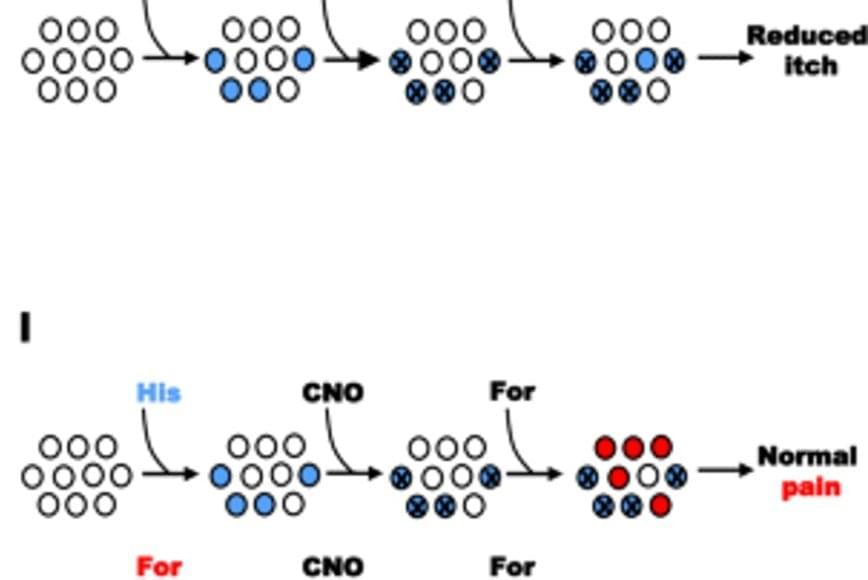He experienced foreign language syndrome for about 24 hours, and remembered every single detail of the incident even after recovery.



1. Non-selective neurons, which respond to both pain and itch stimuli indiscriminately.
2. Stimulus-specific neurons, which were selectively activated by either pain or itch stimuli.
Furthermore, using the dual-eGRASP technique—an advanced synaptic analysis method the research team discovered that stimulus-specific neurons in the ACC receive distinct synaptic inputs from the mediodorsal thalamus (MD). This finding indicates that pain and itch are processed by independent neuronal populations within the ACC, which receive differentiated synaptic inputs, providing fundamental insights into the neural mechanisms of pain and itch processing.
To further confirm the role of these neurons, the team used chemogenetic techniques to selectively deactivate either pain-specific or itch-specific neurons. The results showed suppressing pain neurons reduced pain perception without affecting itch, and vice versa. This discovery suggests that these neurons play a direct role in shaping how we experience pain and itch.
A research team have uncovered the neural mechanisms underlying the processing of pain and itch in the anterior cingulate cortex (ACC). This study provides new insights into how the brain distinguishes between these two distinct sensory experiences.
Pain and itch are both unpleasant sensations, but they trigger different responses—pain often prompts withdrawal, while itching leads to scratching. Until now, scientists have struggled to understand how the brain processes these sensations separately, as they share overlapping neural pathways from the spinal cord to the brain.

How microglia facilitate phagocytosis of multiple types of pathological particles.
The functions, and molecular signaling of elevated glycoprotein non-metastatic melanoma B (GPNMB) in various brain diseases is not been well studied.
The researchers report that GPNMB expression in microglia is commonly induced by multiple types of pathological factors (neuronal degeneration caused by seizures, caspase-3-induced neuronal apoptosis, neuronal debris, and β-amyloid) functionally participating in phagocytosis of pathological particles via interaction with lysosomal vacuolar-type proton ATPase catalytic subunit A (ATP6V1A) and anti-inflammation responses.
GPNMB depletion does not influence the severity of acute seizures but exacerbates the development of chronic epileptogenesis. https://sciencemission.com/microglia-phagocytosis-of-pathological-particles
Liu et al. report that GPNMB expression in microglia is commonly induced by multiple types of pathological factors functionally participating in phagocytosis of pathological particles via interaction with ATP6V1A and anti-inflammation responses. GPNMB depletion does not influence the severity of acute seizures but exacerbates the development of chronic epileptogenesis.
A Global 5G Community, fostering a community and ecosystem around the development of 5G applications.


Qwake Technologies is working with the Department of Homeland Security to test out the device in a real-world environment. 80 fire departments across the country will receive the device to test out. Austin Fire Department and Round Rock Fire Department are both part of this program.
So far, ten of the eighty departments have gotten the technology. Each C-Thru costs about $8,500, which Cossman said is less than the current generation of walkie-talkies used by many departments. The devices are not currently for sale.
“It is the first iPhone for the fire industry. Like this is a watershed moment,” Cossman said.
Don’t judge space junk’s potential for destruction using your Earthly instincts: Traveling at tens of thousands of miles per hour in space, even a small object has the potential to inflict major damage. In one incident that demonstrates that fact of physics, a 2mm piece of space once junk put a 5cm-wide dent in a climate satellite. A modest move up the scale brings much more power: “A one-centimeter piece of debris has the energy of a hand grenade,” ESA’s Tiago Soares told DW.
In an ominous 2009 incident, a Russian Cosmos satellite collided with an Iridium satellite, creating a cloud of about 2,000 pieces of junk measuring 10cm or more. That’s brings us to the nightmare scenario that should fill you with dread: The Kessler Effect. Imagine an initial major impact that creates hundreds of shards, which then start colliding with more orbiting objects, setting off a chain reaction. Actually, you don’t need your imagination. While some scientists say it wasn’t fully accurate in depicting the physics, Hollywood ventured to depict the Kessler Effect in the 2013 movie, Gravity:

A modified manufacturing process for electric vehicle batteries, developed by University of Michigan engineers, could enable high ranges and fast charging in cold weather, solving problems that are turning potential EV buyers away.
“We envision this approach as something that EV battery manufacturers could adopt without major changes to existing factories,” said Neil Dasgupta, U-M associate professor of mechanical engineering and materials science and engineering, and corresponding author of the study published in Joule.
“For the first time, we’ve shown a pathway to simultaneously achieve extreme fast charging at low temperatures, without sacrificing the energy density of the lithium-ion battery.”

Advanced carbon fiber materials could be used in applications from wind turbine blades to biomedical implants following the development of a low-cost carbon fiber feedstock.
The carbon fibers were spun from synergistic blends of the low-value heavy oils left over from crude oil refining by members of KAUST’s Clean Energy Research Platform. The work could not only facilitate broader carbon fiber uptake but also create sustainable new uses for residual oils as the world transitions to alternative energy systems.
“Crude oil is a resource with immense potential beyond fuels,” says Edwin Guevara Romero, a researcher in the labs of Mani Sarathy, who led the work. “Using oil residues as feedstocks for carbon materials is an innovative, high-value application of oil-derived resources, paving the way for economic diversification,” he says.
